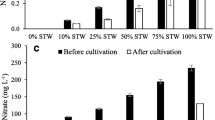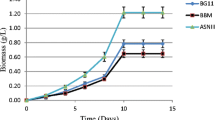Abstract
Using the effluent of municipal wastewater treatment plant (WWTP) to cultivate lipid-producing microalgae is likely to reduce the production cost of algae-derived biodiesel. However, the toxicity of antibiotics present in the effluent may affect the growth of microalgae and lipid production. This study investigated the effects of erythromycin (ERY) and tetracycline (TC) on the growth and lipid production of Tetradesmus (Scenedesmus) obliquus cultivated in the effluent of municipal WWTP. The results indicated that ERY was more toxic to T. obliquus compared to TC. The critical concentrations of ERY resulting in S. obliquus algae growth inhibition and increased lipid accumulation were 100 and 10 μg L−1, respectively. Maximum lipid accumulation was observed at an ERY concentration of 50 μg L−1, while lipid accumulation was significantly decreased at ERY concentrations greater than 250 μg L−1. Interestingly, the contents of polyunsaturated fatty acids in T. obliquus exposed to ERY were significantly increased, while the contents of total saturated fatty acids and monounsaturated fatty acids were significantly decreased. TC had no effect on the growth or lipid production when the concentration reached 500 μg L−1. Overall, the presence of ERY and TC in the municipal WWTP effluent does not largely affect the growth or lipid production of T. obliquus.



Similar content being viewed by others
References
Bligh EG, Dyer WJ (1959) A rapid method of total lipid extraction and purification. Can J Biochem Physiol 37:911–917
Cui H, Meng F, Li F, Wang Y, Duan W, Lin Y (2017) Two-stage mixotrophic cultivation for enhancing the biomass and lipid productivity of Chlorella vulgaris. AMB Express 7:187
Ebert I, Bachmann J, Kühnen U, Küster A, Kussatz C, Maletzki D, Schlüter C (2011) Toxicity of the fluoroquinolone antibiotics enrofloxacin and ciprofloxacin to photoautotrophic aquatic organisms. Environ Toxicol Chem 30:2786–2792
Eguchi K, Nagase H, Ozawa M, Endoh YS, Goto K, Hirata K, Miyamoto K, Yoshimura H (2004) Evaluation of antimicrobial agents for veterinary use in the ecotoxicity test using microalgae. Chemosphere 57(11):1733–1738
González-Pleiter M, Gonzalo S, Rodea-Palomares I, Leganés F, Rosal R, Boltes K, Marco E, Fernández-Piñas F (2013) Toxicity of five antibiotics and their mixtures towards photosynthetic aquatic organisms: Implications for environmental risk assessment. Water Res 47:2050–2064
Halling-Sørensen B (2000) Algal toxicity of antibacterial agents used in intensive farming. Chemosphere 40:731–739
Hartmann A, Alder AC, Koller T, Widmer RM (2010) Identification of fluoroquinolone antibiotics as the main source of umuC genotoxicity in native hospital wastewater. Environ Toxicol Chem 17:377–382
Hirsch R, Ternes T, Haberer K, Kratz KL (1999) Occurrence of antibiotics in the aquatic environment. Sci Total Environ 225:109–118
Ho S-H, Chen C-Y, Chang J-S (2012) Effect of light intensity and nitrogen starvation on CO2 fixation and lipid/carbohydrate production of an indigenous microalga Scenedesmus obliquus CNW-N. Bioresour Technol 113:244–252
Hu Q, Sommerfeld M, Jarvis E, Ghirardi M, Posewitz M, Seibert M, Darzins A (2008) Microalgal triacylglycerols as feedstocks for biofuel production: perspectives and advances. Plant J 54:621–639
Huang G, Chen F, Wei D, Zhang X, Chen G (2010) Biodiesel production by microalgal biotechnology. Appl Energy 87:38–46
Isidori M, Lavorgna M, Nardelli A, Pascarella L, Parrella A (2005) Toxic and genotoxic evaluation of six antibiotics on non-target organisms. Sci Total Environ 346:87–98
Isioma N, Muhammad Y, Sylvester O, Innocent D, Linus O (2013) Cold flow properties and kinematic viscosity of biodiesel. U J Chem 1(4):135–141
Jiang L, Luo S, Fan X, Yang Z, Guo R (2011) Biomass and lipid production of marine microalgae using municipal wastewater and high concentration of CO2. Appl Energy 88:3336–3341
Karthikeyan K, Meyer MT (2006) Occurrence of antibiotics in wastewater treatment facilities in Wisconsin, USA. Sci Total Environ 361:196–207
Kebelmann K, Hornung A, Karsten U, Griffiths G (2013) Intermediate pyrolysis and product identification by TGA and Py-GC/MS of green microalgae and their extracted protein and lipid components. Biomass Bioenergy 49:38–48
Kim G, Bae J, Lee K (2016) Nitrate repletion strategy for enhancing lipid production from marine microalga Tetraselmis sp. Bioresour Technol 205:274–279
Knothe G (2008) “Designer” biodiesel: optimizing fatty ester composition to improve fuel properties. Energy Fuel 22:1358–1364
Lam MK, Lee KT (2012) Microalgae biofuels: a critical review of issues, problems and the way forward. Biotechnol Adv 30:673–690
Li J, Zheng X, Liu K, Sun S, Li X (2016) Effect of tetracycline on the growth and nutrient removal capacity of Chlamydomonas reinhardtii in simulated effluent from wastewater treatment plants. Bioresour Tecnol 218:1163–1169
Machado MD, Soares EV (2019) Sensitivity of freshwater and marine green algae to three compounds of emerging concern. J Appl Phycol 31:399–408
Magdaleno A, Saenz M, Juárez A, Moretton J (2015) Effects of six antibiotics and their binary mixtures on growth of Pseudokirchneriella subcapitata. Ecotoxicol Environ Saf 113:72–78
Nie X, Gu J, Lu J, Pan W, Yang Y (2009) Effects of norfloxacin and butylated hydroxyanisole on the freshwater microalga Scenedesmus obliquus. Ecotoxicology 18(6):677–684
Qian H, Li J, Pan X, Sun Z, Ye C, Jin G, Fu Z (2012) Effects of streptomycin on growth of algae Chlorella vulgaris and Microcystis aeruginosa. Environ Toxicol 27:229–237
Rippka R, Deruelles J, Waterbury JB, Herdman M, Stanier RY (1979) Generic assignments, strain histories and properties of pure cultures of cyanobacteria. J Gen Microbiol 111:1-61
Robinson AA, Belden JB, Lydy MJ (2010) Toxicity of fluoroquinolone antibiotics to aquatic organisms. Environ Toxicol Chem 24:423–430
Serrano M, Oliveros R, Sánchez M, Moraschini A, Martínez M, Aracil J (2014) Influence of blending vegetable oil methyl esters on biodiesel fuel properties: oxidative stability and cold flow properties. Energy 65:109–115
USEPA (2012) Ecological Effects Test Guidelines OCSPP 850.4500:Algal Toxicity
Wan J, Guo P, Peng X, Wen K (2015) Effect of erythromycin exposure on the growth, antioxidant system and photosynthesis of Microcystis flos-aquae. J Hazard Mater 283:778–786
Wynne MJ, Hallan JK (2016) Reinstatement of Tetradesmus G. M. Smith (Sphaeropleales, Chlorophyta). Feddes Repertorium 126:83–86
Xin L, Hong-ying H, Ke G, Ying-xue S (2010) Effects of different nitrogen and phosphorus concentrations on the growth, nutrient uptake, and lipid accumulation of a freshwater microalga Scenedesmus sp. Bioresour Technol 101:5494–5500
Xiong JQ, Kim SJ, Kurade MB, Govindwar S, Abou-Shanab RA, Kim JR, Roh HS, Khan MA, Jeon BH (2019) Combined effects of sulfamethazine and sulfamethoxazole on a freshwater microalga, Scenedesmus obliquus: toxicity, biodegradation, and metabolic fate. J Hazard Mater 370:138–146
Yang W, Tang Z, Zhou F, Zhang W, Song L (2013) Toxicity studies of tetracycline on Microcystis aeruginosa and Selenastrum capricornutum. Environ Toxicol and Phar 35(2):320–324
Zhang QQ, Ying GG, Pan CG, Liu YS, Zhao JL (2015) Comprehensive evaluation of antibiotics emission and fate in the river basins of China: source analysis, multimedia modeling, and linkage to bacterial resistance. Environ Sci Technol. 49(11):6772–6782
Funding
This study is financially supported by the National Science and Technology Support Plan of China (2011BAD14B04).
Author information
Authors and Affiliations
Corresponding author
Additional information
Publisher’s note
Springer Nature remains neutral with regard to jurisdictional claims in published maps and institutional affiliations.
Rights and permissions
About this article
Cite this article
Du, S., Dou, X., Meng, F. et al. Effects of two common antibiotics on the growth and lipid production of Tetradesmus obliquus cultivated in the effluent of municipal wastewater treatment plant. J Appl Phycol 32, 389–397 (2020). https://doi.org/10.1007/s10811-019-01945-z
Received:
Revised:
Accepted:
Published:
Issue Date:
DOI: https://doi.org/10.1007/s10811-019-01945-z




